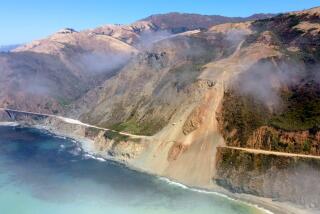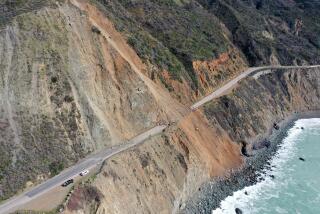23 miles of Highway 1 near Big Sur are closed. Repairs will take months
Caltrans officials say landslide repairs will keep Highway 1 south of Big Sur closed for months, rewriting travel plans for anyone who had been hoping to make a coastal road trip from Southern California in early spring.
Beyond that, “It is too early to establish a timeline,” Caltrans spokesman Kevin Drabinski said. Though Monterey County officials partially lifted a storm-related evacuation order in the area Monday afternoon, the debris flow in some places “is still active. … And we have rain coming as soon as tonight.”
The biggest problem is a 150-foot-long chasm where the highway used to run at Rat Creek, two miles south of the Esalen Institute. That area, authorities noted, lies below the “burn scar” left by the Dolan fire, which blackened about 125,000 acres last August.
In addition to the Rat Creek damage, authorities said about 60 points along the highway suffered damage. Many “need to dry out and stabilize before we can get in there and do full repairs and cleanup,” Drabinski said.
Until the coast route reopens, the only way from Southern California to the dramatic coastline of Big Sur is to drive up U.S. 101 to Salinas, then loop back along the coast through Carmel.
Get inspired to get away.
Explore California, the West and beyond with the weekly Escapes newsletter.
You may occasionally receive promotional content from the Los Angeles Times.
Once Caltrans has reset the highway closures (due Monday evening), northbound drivers on Highway 1 will still be able to reach San Simeon, Hearst Castle (which is closed because of COVID-19), Ragged Point and Gorda, crossing the line from San Luis Obispo County into Monterey County. But the coast road is to be closed 11.1 miles past the county line, at Willow Creek Road.
Southbound visitors from the Bay Area and other points north can still access Big Sur’s restaurants, lodgings, shops and parks, most of which remain open. For them, southbound traffic will stop near South Coast Center at milepost 34, about 2 miles south of Julia Pfeiffer Burns State Park and the iconic scenery of McWay Falls. (About 1.6 miles beyond the roadblock and closed to the public: Esalen Institute, which planned to reopen March 1.)
The hillside saturation and slide took place Jan. 28 and 29 as rains were soaking much of the state.
Caltrans officials say that last Thursday, road crews found debris flows had washed out the southbound lane of the two-lane highway. When the crews returned the next morning, officials said, more flows had washed out the northbound lane as well.
Emergency crews started by closing 44 miles of the famously scenic but fragile highway, from Fuller’s Point (north) to Ragged Point (south). On Monday at 6 p.m., after sending drones aloft to map the site, crews were expected to open northern and southern portions of the closed road, reducing the closed zone to 22.8 miles.
Get The Wild newsletter.
The essential weekly guide to enjoying the outdoors in Southern California. Insider tips on the best of our beaches, trails, parks, deserts, forests and mountains.
You may occasionally receive promotional content from the Los Angeles Times.
Drabinski noted that those miles are closed not only to cars but to bicycles and pedestrians “because it’s an active construction zone, and the highway is not fit for public use.” However, he said, “We hope to keep moving the southern border north and the northern border south” as work advances.
The highway reopened in July 2018 after a 14-month landslide-repair closure, that one at Mud Creek.
The closure’s impact on businesses is relatively muted at the moment, said Kirk Gafill, president of the Big Sur Chamber of Commerce. He noted that this is the slowest time of year and, under pandemic restrictions, many businesses are limited in how many people they can serve.
Businesses could see an estimated 30% dip in revenue during spring and summer, the area’s busiest seasons, Gafill said, noting that an estimated two-thirds of Big Sur’s visitors come from Northern California.
“Big Sur is a secluded area to begin with,” said Tyler Rue, general manager of COAST Big Sur cafe and gallery. “When you cut off this major artery, it becomes even more secluded.”
Despite the headaches the wildfires, COVID-19 requirements and land collapse have caused local business owners, Rue said, “The Big Sur community is extremely resilient and tight-knit. We work well together to come up with solutions.”
Drabinski said traffic checkpoints will allow residents of Big Sur access to the area where safety allows it. He noted that because of Big Sur’s long-standing vulnerability to the weather, residents “are very self-sufficient. They’re accustomed to power outages and road closures. They’re a very hardy community, and we’re trying to open up the highway just as soon as possible.”
More to Read
Sign up for The Wild
We’ll help you find the best places to hike, bike and run, as well as the perfect silent spots for meditation and yoga.
You may occasionally receive promotional content from the Los Angeles Times.








